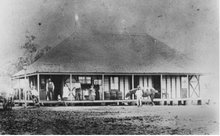What do you do when you have a small, elderly house, several children and not a lot of money? According to a (former) Sydney friend, you knock your house down and build yourself a proper one. Other people have other ideas, none of which seem sympathetic to an eighty-year old house. What do you do if you actually love your house? I must add here that there are people who like wooden houses and people who don’t and the two tend to speak different languages. It’s a bit like L.M. Montgomery’s notion of the “tribe of Jacob” and the rest.
The first thing you do is to find a builder who will build in wood and likes old houses. When you have talked to every builder in the phone book, you will find a few who seem interested. Then you get them to make a site visit, give you some ideas and give you a quote. After you have recovered from the shock and graciously declined their exorbitant prices, you fix up your current house to make it liveable while you mull over ideas for several years.
Then you start looking around for another house to buy. Not to move yourself to, but to move onto your property. It has to be the right house. It has to have high ceilings (at least 3000mm), vertical joists (called vj in the vernacular and a term I only learnt in the last five years) for walls, weatherboard exterior and some charm. It has to be of a similar era and small. After all we don’t want a mansion and it has to fit a particular space on our land. And it has to be physically sound and solid.
After about a year, you start to wonder if you will ever find this elusive dream. Your friendly house contractor suggests just buying a house and putting fake vj cladding over the walls. He suggests that you will get used to low ceilings after a while and not notice them. You notice that he is quite short and has probably never had the feeling of fan blades whirling near his ears. You spend weekends looking at decaying houses. You study old houses, big houses, decrepit houses, expensive houses on the internet. You learn about fascias and soffits and tail boards. You can tell the difference between colonial and Queenslander styles and identify an asymmetrical bungalow. You start to get the feeling that house moving contractors don’t really want to talk to you.
And then, you find it. It looks shabby and tired, dwarfed by a shopping centre and development all around. The agent can’t find the key so you measure the outside and it’s the right size. You try not to get too excited. Then the inside is just right. The configuration is right to join up to your house. The price is about right (well you’d always like to spend less money). You do the legals and practicals and pay the deposit and still don’t believe that it’s happening. Then you look on the internet and it has a SOLD sign on it and it officially belongs to you.
Never mind that it’s not on site yet or that there’s a lot of work to go. It has to travel sixty kilometres on the back of a truck, be hauled by bulldozer up a steep hill and over a horse paddock. It has to be restumped, a hallway built to join it to the original house and a new roof added. But it’s on its way and we are now participating in that most peculiar of Queensland phenomenon – the removal house.
In a way it’s buying history, but you can also think of it as conservation and preservation. It’s even environmentally sound to be recycling a house. I just hope that the whole process doesn’t suck up all available time in the next few months. I can just picture myself trying to write, keep the children out of the building site and track down materials and absent carpenters. Whatever happens, I’m sure that you will hear more about it.
Subscribe to:
Post Comments (Atom)

No comments:
Post a Comment